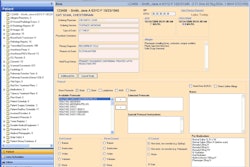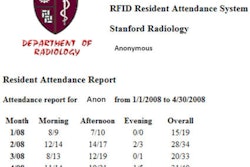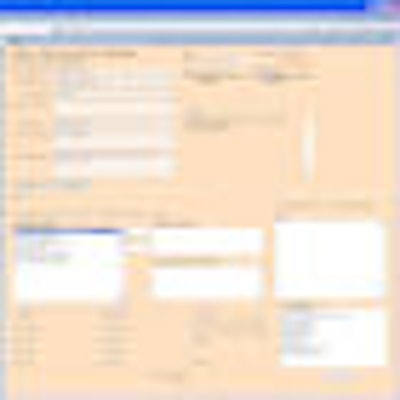
At first glance, a program that automates CT protocol selection by radiologists may not seem to be a critically important software efficiency solution, but it's worth its weight in gold when a radiology department performs hundreds of CT examinations a day.
That's the case at M. D. Anderson Cancer Center at the University of Texas in Houston, where radiologic technologists perform an average of 700 body and chest CT exams each day. The hospital's radiology department saw a major improvement in efficiency when it adopted a CT protocol ordering system to replace manual order forms sent by fax and courier.
Even though M. D. Anderson's radiology department has been filmless and nearly paperless since implementing an enterprise PACS in November 2005, the process of managing CT protocols was paper-based. Not only was this labor intensive, costly, and inefficient from the perspective of radiologists and support staff, it also occasionally caused a CT exam to be postponed or delayed.
The department implemented an automated protocol order entry and management system for CT imaging in April 2007, and the system paid for itself in a matter of months. Dr. Kevin McEnery, professor of radiology, and colleagues described the advantages of the system in a poster presentation at the RSNA 2008 annual meeting.
Prior to implementing the electronic system, a paper form listing scanner protocols had to be created for every CT exam ordered. The process consisted of verifying clinical history in the electronic medical record (EMR), collating clinical and lab information, and writing relevant information on the form.
The form would be sent by fax or courier from one of four locations on the hospital's campus to a radiologist, who needed to make eight pen entries to complete the form, which then would be returned by fax or courier to its originating location. If the information contained on a protocol form was unclear or incomplete, it would be necessary to interrupt the radiologist with a page or a phone call. If paperwork was lost, there would be further delays.
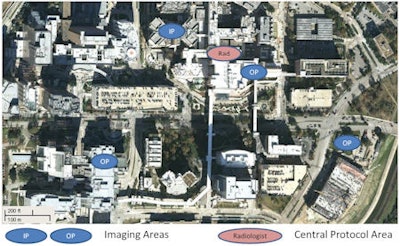 |
| Image courtesy of Dr. Kevin McEnery. |
In April 2007, a CT protocol management system was implemented as a clinical module within ClinicStation, a clinical information retrieval system developed by the hospital's division of diagnostic imaging informatics. ClinicStation was developed in collaboration with radiologists, nurses, technologists, and informatics staff.
Protocol entry is restricted to specific clinical staff but is accessible for viewing by all authorized electronic medical record users. Protocol changes are managed through an established change-control process.
A service-oriented architecture integrates schedule data from the HIS, clinical data from the order entry system, allergy information from the EMR, laboratory data from the laboratory information system, previous scan data from the RIS, and relevant priors from the PACS. Navigation folders make all this information immediately accessible for review.
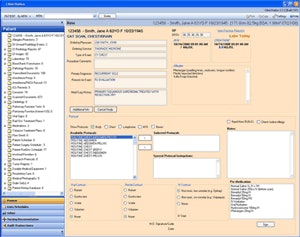 |
| Click here to enlarge this image. |
| Sample electronic form. Image courtesy of Dr. Kevin McEnery. |
The electronic form is automatically populated with patient demographic information, clinical history, allergies, laboratory information, and the type of CT exam ordered. Radiologists can specify the protocol and type of contrast using pull-down menus. When a protocol is selected, default protocol parameters are set for oral, rectal, and intravenous contrast, and special procedure instructions are also included with specific protocols.
"The form has been designed so that radiologists can complete the form with two mouse clicks, one to sign in and the other to select the protocol," McEnery said.
Premedication orders are specified by selecting one or more medications from a pull-down menu. The protocol signature also serves as the medication order signature, creating a permanent document at the same time.
An exam notes feature enables nursing staff to request protocol clarifications and eliminates the need to phone or page the radiologist. A change history feature provides an audit record of all changes to the protocol, identifies the radiologist who signed the protocol order, and identifies the nurse who administered contrast or premedications.
Between April 2007 and November 2008, more than 100,000 protocols have been successfully processed using the system. Anecdotally, CT managers report greater department efficiency, as previously experienced delays caused by inefficient transportation or faxing of protocol sheets have been eliminated. "Protocol runners" have been reassigned to other jobs within M. D. Anderson.
Best of all, the software's service-based architecture is robust, easily expandable, and upgradeable. The department plans to expand the automation into other modality areas.
By Cynthia E. Keen
AuntMinnie.com staff writer
January 29, 2009
Copyright © 2009 AuntMinnie.com






